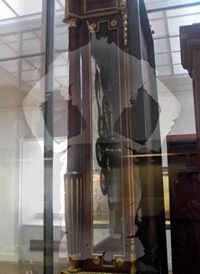Point de suture
 Sandclock
Sandclock
Science, Technology, Fine Arts and Industry, the current representations of which force us to perceive as clearly separated, not to say partitioned or sometimes even opposed activity fields,, originally were considered as different facets of a single set of practices that the Middle Ages used to call the Arts, and that more or less covered all human activities except agriculture, hunting and gathering.
Etymology as well as texts allow one to check that the different firelds of the Arts were not perceived as individual disciplines before the 17th and 18th centuries, as may be seen from the vast unitarian project led by Diderot and D'Alembert of the Encyclopedia, in other terms, according to the subtitle, a Reasoned Dictionary of Sciences, Arts and Trades.
The separation of Fine Arts and Science which ruined the previously common stream of the Arts was only achieved in the 19th century with the generalisation of Industry. Since this moment distances only increased between Science, Technology, Fine Arts and Industry and, in a tree-like manner the crack further propagated within these disciplines themselves, and even within their subparts.
The most common explanation of this evolution lies in the myth of the Tower of Babel, although its religious origin is rarely reminded : development and specialization would have resulted in a growing mutual misunderstanding, a regrettable but necessary drawback that we should learn to live with.
One may however have some doubts about this point. Not only because the supposed basis of such a resignation is of religious origin, but deeper, because it is rooted in only one religious tradition that cannot stand for all of them.
And anyway, this reference to the myth of Babel would not suffice to explain the movement of distrust and disrepute that stroke Fine Arts, Sciences, Technology and Industry one after the other in the last two centuries.
As regards Fine Arts, the sort of ignorance and specific kind of contempt that is now attached to them in the popular, commercial, technical and scientific circles , started to spread as soon as the romantic period and reached a kind of standard level with Dada in the beginning of the XXe century. The resulting situation regarding Fine Arts is quite the opposite of the interest and support they enjoyed in Florence in the Quattrocento.
Point de suture - Pierre Petiot - Mars 2008
LaBelleInutile